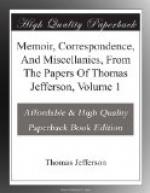the several states, and of the comparative value of
the foreign coins chiefly in circulation with us,
He went into the consideration of the necessity of
establishing a standard of value with us, and of the
adoption of a money unit. He proposed for that
unit, such a fraction of pure silver as would be a
common measure of the penny of every state, without
leaving a fraction. This common divisor he found
to be 1/1440 of a dollar, or 1/1600 the crown sterling.
The value of a dollar was, therefore, to be expressed
by 1440 units, and of a crown by 1600; each unit containing
a quarter of a grain of fine silver. Congress
turning again their attention to this subject the
following year, the Financier, by a letter of April
30,1783, further explained and urged the unit he had
proposed: but nothing more was done on it until
the ensuing year, when it was again taken up, and
referred to a committee, of which I was a member.
The general views of the Financier were sound, and
the principle was ingenious, on which he proposed
to found his unit; but it was too minute for ordinary
use, too laborious for computation, either by the head
or in figures. The price of a loaf of bread,
1/20 of a dollar, would be 72 units. A pound
of butter, 1/5 of a dollar, 288 units. A horse,
or bullock, of eighty dollars’ value, would
require a notation of six figures, to wit, 115,200,
and the public debt, suppose of eighty millions, would
require twelve figures, to wit, 115,200,000,000 units.
Such a system of money-arithmetic would be entirely
unmanageable for the common purposes of society.
I proposed, therefore, instead of this, to adopt the
Dollar as our unit of account and payment, and that
its divisions and subdivisions should be in the decimal
ratio. I wrote some Notes on the subject, which
I submitted to the consideration of the Financier.
I received his answer and adherence to his general
system, only agreeing to take for his unit one hundred
of those he first proposed, so that a Dollar should
be 14 40/100 and a crown 16 units. I replied
to this, and printed my Notes and Reply on a flying
sheet, which I put into the hands of the members of
Congress for consideration, and the Committee agreed
to report on my principle. This was adopted the
ensuing year, and is the system which now prevails.
I insert, here, the Notes and Reply, as showing the
different views on which the adoption of our money
system hung. [See Appendix, note F.]The divisions into
dismes, cents, and mills is now so well understood,
that it would be easy of introduction into the kindred
branches of weights and measures. I use, when
I travel, an Odometer of Clarke’s invention,
which divides the mile into cents, and I find every
one comprehends a distance readily, when stated to
him in miles and cents; so he would in feet and cents,
pounds and cents, &c.




